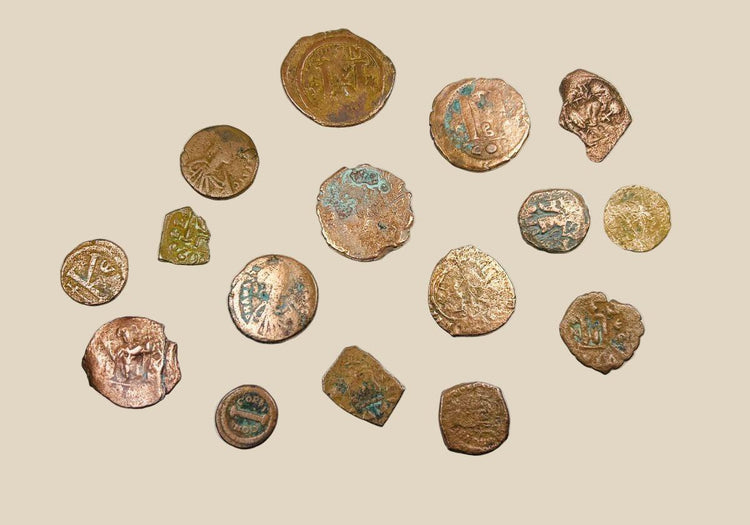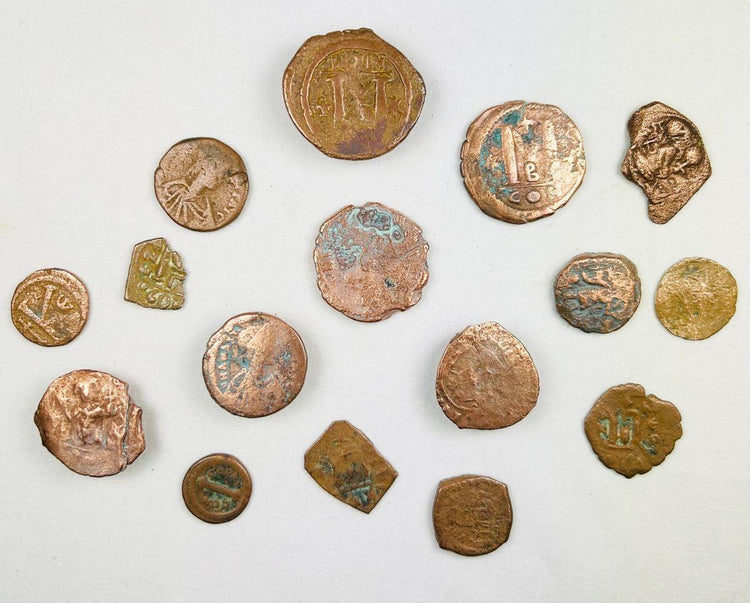Lot of 16 | Ancient Roman & Byzantine | Bronze Coins | Circa 2nd-7th Century AD
Description
More
Less
Historical Context & Origin
Region: Mediterranean World (Roman and Byzantine Empires)
Material: Bronze alloy with natural patina
Period: 3rd–7th Century AD
Description
This curated set of sixteen bronze coins spans the transitional period from the late Roman Empire to the early Byzantine era. Struck across imperial mints from the 3rd through 7th centuries AD, these coins circulated widely among soldiers, merchants, and citizens throughout the Mediterranean world. Each coin bears distinct iconography—ranging from imperial busts to Christian symbols and monograms—reflecting the shift from pagan Rome to Christian Byzantium. Together, they embody a remarkable continuum of political power, religious change, and daily commerce across centuries.
Features
- Selection of 16 authentic bronze coins from Roman and Byzantine periods
- Varied designs including imperial portraits, Chi-Rho monograms, and crosses
- Some coins with large “M” and “K” numerals indicating follis denominations
- Distinct natural patinas from green to blue, with mineral encrustations from burial
- Mixed flan shapes and sizes, consistent with late antique minting practices
Cultural Significance
Bronze coinage was indispensable to ancient society—used in trade, military pay, and temple offerings. Beyond their economic role, these coins served as imperial propaganda, carrying the images and symbols of power across vast territories. The progression from Roman busts to Byzantine Christian iconography represents one of the most significant cultural transformations in history: the rise of Christianity and the endurance of imperial authority.
Condition
Coins are in excavated condition with variable wear, ranging from partially legible to moderately clear inscriptions and imagery. Each retains its unique character, with natural burial patina and surface encrustations. No modern restoration has been applied, ensuring authenticity and archaeological integrity.
Dimensions (approximate)
Diameter range: Largest 1.5 in
Age
Estimated 1,300–1,700 years old
Description
Historical Context & Origin
Region: Mediterranean World (Roman and Byzantine Empires)
Material: Bronze alloy with natural patina
Period: 3rd–7th Century AD
Description
This curated set of sixteen bronze coins spans the transitional period from the late Roman Empire to the early Byzantine era. Struck across imperial mints from the 3rd through 7th centuries AD, these coins circulated widely among soldiers, merchants, and citizens throughout the Mediterranean world. Each coin bears distinct iconography—ranging from imperial busts to Christian symbols and monograms—reflecting the shift from pagan Rome to Christian Byzantium. Together, they embody a remarkable continuum of political power, religious change, and daily commerce across centuries.
Features
- Selection of 16 authentic bronze coins from Roman and Byzantine periods
- Varied designs including imperial portraits, Chi-Rho monograms, and crosses
- Some coins with large “M” and “K” numerals indicating follis denominations
- Distinct natural patinas from green to blue, with mineral encrustations from burial
- Mixed flan shapes and sizes, consistent with late antique minting practices
Cultural Significance
Bronze coinage was indispensable to ancient society—used in trade, military pay, and temple offerings. Beyond their economic role, these coins served as imperial propaganda, carrying the images and symbols of power across vast territories. The progression from Roman busts to Byzantine Christian iconography represents one of the most significant cultural transformations in history: the rise of Christianity and the endurance of imperial authority.
Condition
Coins are in excavated condition with variable wear, ranging from partially legible to moderately clear inscriptions and imagery. Each retains its unique character, with natural burial patina and surface encrustations. No modern restoration has been applied, ensuring authenticity and archaeological integrity.
Dimensions (approximate)
Diameter range: Largest 1.5 in
Age
Estimated 1,300–1,700 years old
You May Also Like














